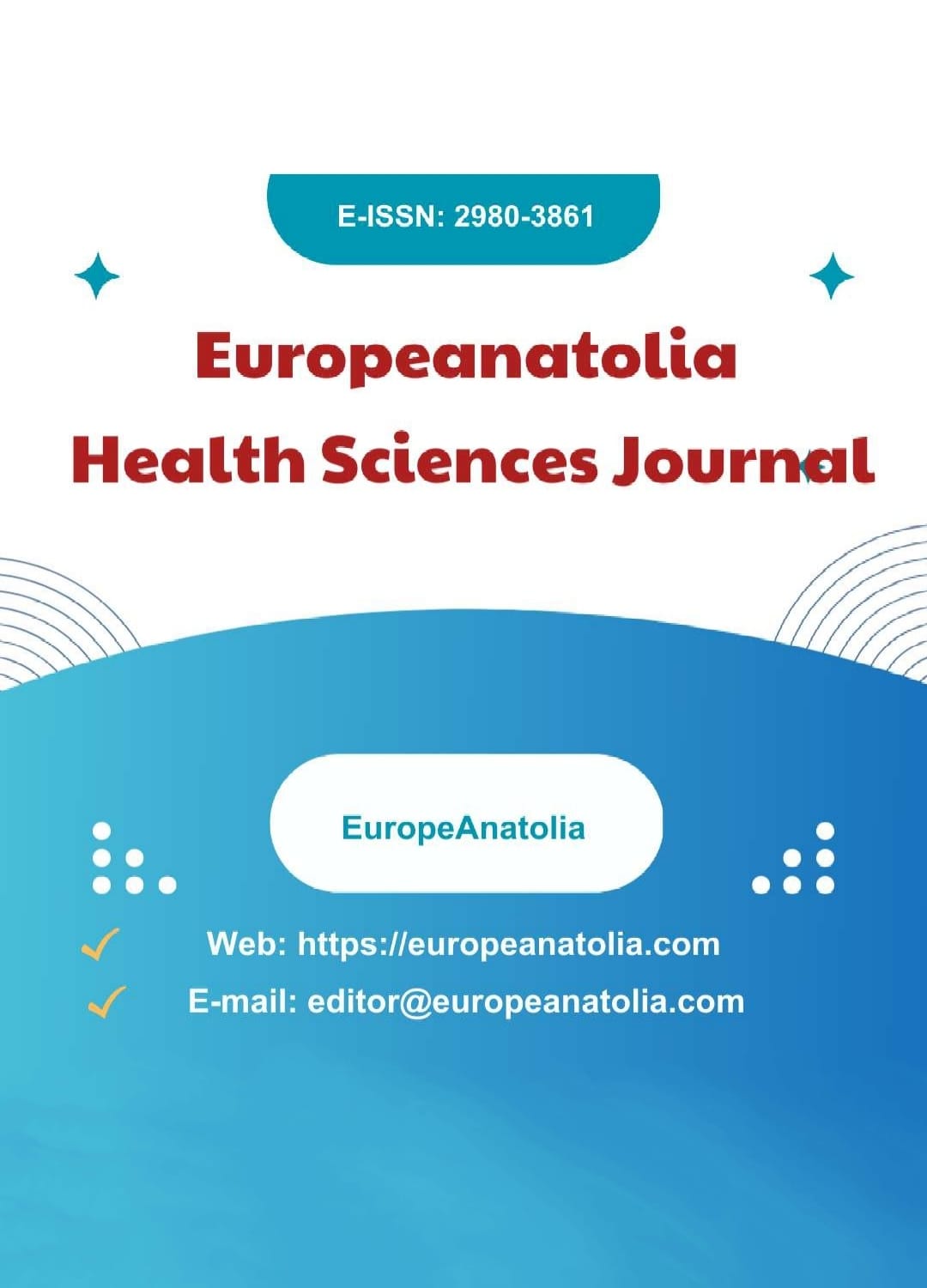Effect of Stress Perception Level of Safety Workers on Musculoskeletal Pain in COVID-19 Outbreak
Research Article
DOI:
https://doi.org/10.5281/zenodo.10396311Keywords:
Outbreaks, Pain, StressAbstract
Purpose: In this study, it was aimed to examine the relationship between musculoskeletal pain and perceived stress levels in safety workers during the COVID-19 outbreak.
Materials and Methods: 116 police officers, male (83.6%) and female (16.4%), who were actively working in different status and units, participated in the study in April 2019. “Expanded Nordic Musculoskeletal System Questionnaire” was used to inquire about musculoskeletal disorders and Perceived Stress Scale was used to determine perceived stress. A Demographic Information Form consisting of demographic information and descriptive questions about the epidemic process was used.
Results: When the perceived stress level was compared with pain in the last 12 months, work disability due to pain in the last 12 months, and presence of pain in the last 7 days, a significant relationship was found between the presence of knee pain in the last 12 months and the perceived stress level (p = 0.030).
Discussion: We think that during the COVID-19 epidemic, it contributed to the literature on the point that there is a positive relationship between the presence of knee pain in the last.
References
Akbağ, Müge. (2000). “Stresle Başaçıkma Tarzlarının Üniversite Öğrencilerinde Olumsuz Otomatik Düşünceler, Transaksiyonel Analiz Ego Durumları ve Bazı Değişkenler Açısından Incelenmesi.”
Amin, Nur Azma, Rusli Nordin, Quek Kia Fatt, Rahim M Noah, and Jennifer Oxley. (2014). “Relationship between Psychosocial Risk Factors and Work-Related Musculoskeletal Disorders among Public Hospital Nurses in Malaysia.” Annals of Occupational and Environmental Medicine 26 (1): 23. https://doi.org/10.1186/s40557-014-0023-2.
Aşkın, Alev. (2019). “Sağlık Çalışanlarının (Doktor ve Hemşireler) Serbest Zaman Faaliyetlerine Katılım Zamanları Ile Algılanan Stres Düzeyleri, Psikolojik Dayanıklıkları Arasındaki Ilişkinin Analizi (SBÜ Dr. Siyami Ersek Gögüs Kalp Damar Cerrahisi Eğitim ve Araştırma Hastanes.” İstanbul Gelişim Üniversitesi Sağlık Bilimleri Enstitüsü.
Athirah Diyana, M Y, K Karmegam, B M T Shamsul, R Irniza, H Vivien, S Sivasankar, M J Putri Anis Syahira, and K C M Kulanthayan. (2019). “Risk Factors Analysis: Work-Related Musculoskeletal Disorders among Male Traffic Policemen Using High-Powered Motorcycles.” International Journal of Industrial Ergonomics 74: 102863. https://doi.org/https://doi.org/10.1016/j.ergon.2019.102863.
Brown, Jeremy J, George A Wells, Alain J Trottier, Jean Bonneau, and Blake Ferris. (1998). “Back Pain in a Large Canadian Police Force.” Spine 23 (7): 821–27.
Chew, Nicholas W S, Grace K H Lee, Benjamin Y Q Tan, Mingxue Jing, Yihui Goh, Nicholas J H Ngiam, Leonard L L Yeo, Aftab Ahmad, Faheem Ahmed Khan, and Ganesh Napolean Shanmugam. (2020). “A Multinational, Multicentre Study on the Psychological Outcomes and Associated Physical Symptoms amongst Healthcare Workers during COVID-19 Outbreak.” Brain, Behavior, and Immunity.
Cho, Taek-Sang, Woo-Jin Jeon, Jin-Gu Lee, Jong-Min Seok, and Jae-Hwan Cho. (2014). “Factors Affecting the Musculoskeletal Symptoms of Korean Police Officers.” Journal of Physical Therapy Science 26 (6): 925–30.
Choinière, Manon, Dominique Dion, Philip Peng, Robert Banner, Pamela M Barton, Aline Boulanger, Alexander J Clark, Allan S Gordon, Denise N Guerriere, and Marie-Claude Guertin. (2010). “The Canadian STOP-PAIN Project–Part 1: Who Are the Patients on the Waitlists of Multidisciplinary Pain Treatment Facilities?” Canadian Journal of Anesthesia/Journal Canadien d’anesthésie 57 (6): 539–48.
Crawford, Joanne O. (2007). “The Nordic Musculoskeletal Questionnaire.” Occupational Medicine 57 (4): 300–301.
Cüceloğlu, D. (1993). “İnsan ve Davranışı: Psikolojinin Temel Kavramları.[Human And Behavior: Basic Concepts of Psychology].” İstanbul, Turkey: Remzi Kitapevi.
Eccleston, Christopher, Fiona M Blyth, Blake F Dear, Emma A Fisher, Francis J Keefe, Mary E Lynch, Tonya M Palermo, M Carrington Reid, and Amanda C de C Williams. (2020). “Managing Patients with Chronic Pain during the COVID-19 Outbreak: Considerations for the Rapid Introduction of Remotely Supported (EHealth) Pain Management Services.” Pain 161 (5): 889.
Elkind, Andrea Knopf. (1988). “Do Nurses Smoke Because of Stress?” Journal of Advanced Nursing 13 (6): 733–45.
Eskin, Mehmet, Hacer Harlak, Fatma Demirkiran, and Çiǧdem Dereboy. (2013). “The Adaptation of the Perceived Stress Scale into Turkish: A Reliability and Validity Analysis.” Yeni Symposium 51 (3): 132–40.
Huang, Chaolin, Yeming Wang, Xingwang Li, Lili Ren, Jianping Zhao, Yi Hu, Li Zhang, Guohui Fan, Jiuyang Xu, and Xiaoying Gu. (2020). “Clinical Features of Patients Infected with 2019 Novel Coronavirus in Wuhan, China.” The Lancet 395 (10223): 497–506.
Huang, J Z, M F Han, T D Luo, A K Ren, and X P Zhou. (2020). “Mental Health Survey of 230 Medical Staff in a Tertiary Infectious Disease Hospital for COVID-19.” Zhonghua Lao Dong Wei Sheng Zhi Ye Bing Za Zhi= Zhonghua Laodong Weisheng Zhiyebing Zazhi= Chinese Journal of Industrial Hygiene and Occupational Diseases 38: E001–E001.
Kafry, Ditsa, and Ayala Pines. (1980). “The Experience of Tedium in Life and Work.” Human Relations 33 (7): 477–503.
Kahraman, Turhan, Arzu Genc, and Evrim Göz. (2016). The Nordic Musculoskeletal Questionnaire: Cross-Cultural Adaptation into Turkish Assessing Its Psychometric Properties. Disability and Rehabilitation. Vol. 38. https://doi.org/10.3109/09638288.2015.1114034.
“Koronavirüs Hastalığı (COVID-19).” n.d.
Li, Qun, Xuhua Guan, Peng Wu, Xiaoye Wang, Lei Zhou, Yeqing Tong, Ruiqi Ren, et al. (2020). “Early Transmission Dynamics in Wuhan, China, of Novel Coronavirus–Infected Pneumonia.” New England Journal of Medicine 382 (13): 1199–1207. https://doi.org/10.1056/NEJMoa2001316.
Li, Zhenyu, Jingwu Ge, Meiling Yang, Jianping Feng, Mei Qiao, Riyue Jiang, Jiangjiang Bi, Gaofeng Zhan, Xiaolin Xu, and Long Wang. (2020). “Vicarious Traumatization in the General Public, Members, and Non-Members of Medical Teams Aiding in COVID-19 Control.” Brain, Behavior, and Immunity.
Mehrdad, Ramin, Jack T Dennerlein, Mohammad Haghighat, and Omid Aminian. (2010). “Association between Psychosocial Factors and Musculoskeletal Symptoms among Iranian Nurses.” American Journal of Industrial Medicine 53 (10): 1032–39.
Mirbod, Seyed Mohammad, Hideyo Yoshida, Marjan Jamali, Kazuhito Masamura, Ryoichi Inaba, and Hirotoshi Iwata. (1997). “Assessment of Hand-Arm Vibration Exposure among Traffic Police Motorcyclists.” International Archives of Occupational and Environmental Health 70 (1): 22–28.
Mo, Yuanyuan, Lan Deng, Liyan Zhang, Qiuyan Lang, Chunyan Liao, Nannan Wang, Mingqin Qin, and Huiqiao Huang. (2020). “Work Stress among Chinese Nurses to Support Wuhan in Fighting against COVID‐19 Epidemic.” Journal of Nursing Management.
Nazmul Hasan, Mohammad. (2013). “Prevalence of Low Back Pain among the Traffic Police.” Department of Physiotherapy, Bangladesh Health Professions Institute, CRP.
Organization, World Health. (2020). “Mental Health and Psychosocial Considerations during the COVID-19 Outbreak, 18 March 2020.” World Health Organization.
Özdemir, İmge. (2013). “Aile Yanında Yaşayan ve Ailesinden Ayrı Yaşayan Üniversite Öğrencilerinin Algılanan Sosyal Destek, Stresle Başa Çıkma Tarzları, Kaygı Düzeyleri ve Psikolojik Belirtiler Açısından Karşılaştırılması.” Sosyal Bilimler Enstitüsü.
Parrott, Andy C. (1999). “Does Cigarette Smoking Cause Stress?” American Psychologist 54 (10): 817.
Pines, Ayala, and Ditsa Kafry. (1978). “Occupational Tedium in the Social Services.” Social Work 23 (6): 499–507.
Robles, Zuzuky, Lorra Garey, Julianna Hogan, Jafar Bakhshaie, Norman B Schmidt, and Michael J Zvolensky. (2016). “Examining an Underlying Mechanism between Perceived Stress and Smoking Cessation-Related Outcomes.” Addictive Behaviors 58: 149–54. https://doi.org/https://doi.org/10.1016/j.addbeh.2016.02.022.
Rufai, Adamu Ahmad, Adewale Luqman Oyeyemi, Stanley Monday Maduagwu, Abah Daniel Fredrick, Salamatu Umar Aliyu, and Aliyu Lawan. (2019). “Work-Related Musculoskeletal Disorders among Nigerian Police Force.” Nigerian Journal of Basic and Clinical Sciences 16 (2): 127.
Solis, Julie, Sheldon Cohen, Tom Kamarck, and Robin Mermelstein. (1983). “A GLOBAL MEASURE OF PERCEIVED STRESS.” Journal of Health and Social Behavior. Vol. 24.
Stogner, John, Bryan Lee Miller, and Kyle McLean. (2020). “Police Stress, Mental Health, and Resiliency during the COVID-19 Pandemic.” American Journal of Criminal Justice 45 (4): 718–30. https://doi.org/10.1007/s12103-020-09548-y.
T.C Sağlık Bakanlığı. (2020). “T.C Sağlık Bakanlığı Korona Tablosu.” T.C Sağlık Bakanlığı. 2020.
Terry, Ellen L, M Dottington Fullwood, Staja Q Booker, Josue S Cardoso, Kimberly T Sibille, Toni L Glover, Kathryn A Thompson, Adriana S Addison, Burel R Goodin, and Roland Staud. (2020). “Everyday Discrimination in Adults with Knee Pain: The Role of Perceived Stress and Pain Catastrophizing.” Journal of Pain Research 13: 883.
Trindade, Ana Paula Nassif Tondato da, Luis Carlos Nobre de Oliveira, Branca Maria de Oliveira Santos, Fabricio Borges Oliveira, and Paulo Roberto Veiga Quemelo. (2015). “Symptoms of Musculoskeletal Disorders among Police Officers.” Arquivos de Ciências Da Saúde 22 (2): 42–45.
Zandifar, Atefeh, and Rahim Badrfam. (2020). “Iranian Mental Health during the COVID-19 Epidemic.” Asian Journal of Psychiatry 51.
Downloads
Published
How to Cite
Issue
Section
License
Copyright (c) 2023 Europeanatolia Health Sciences Journal

This work is licensed under a Creative Commons Attribution 4.0 International License.










